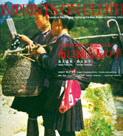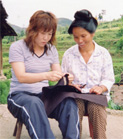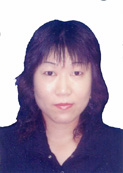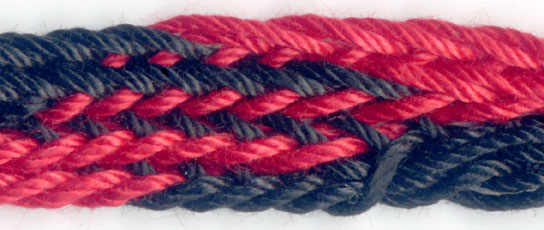|
|
|
Workshop general
|
|
Workshop program
|
|
Application
|
|
|
Materials fee
400 yen for threads
|
|
 |
|
Author's book 2004
|
 |
|
Tomoko Torimaru
|
 |
|
Tomoko Torimaru
|
|
|
Students
|
Yoshiko Ichimura
Giovanna Imperia
Ethel Kawamura
Ria Luiten
Shigei Mizobuchi
Leigh Morris
Kunie Ninomiya
Mika Nakamura
Mayumi Nomura
Ayako Okamoto
Jennie Parry
Anne Percival
Molly Pere
None Redmond
Misako Shintani
Sue Stevenson
Richard Sutherland
Tunde Tuskes
Carol Wang
(19 of 20) |
|
| Tomoko Torimaru |
Fukuoka, Japan
|
|
Unique Kumihimo of the Miao People of Guizhou, China
The Chinese Miao people produce very fine and colorful braids often used in embroidery
to create complex patterns and unique 3-D effects to embellish Miao costumes. They
also make braids for daily use with an ingeniously simple plaiting method which differs
from Japanese Kumihimo since it does not use a conventional stand. This class will
enlighten experienced weavers, braiders, and embroiders. and will be a great introduction
to novices as well. |
• PRESENT POSITION
Independent Scholar
• EDUCATION
PhD, History and Technology of Chinese Textiles. Donghua University, Shanghai,
China, 2004.
Dissertation: Study of Origin, Development, and Dissemination of Warp-float, Warp-faced
Plain Weaving in China - preliminary research on the origin of Kenjo Hakata obi in
Japan
M.F.A., Historical and Modern Techniques in Tablet Weaving and Textile Bands
in China. Donghua University, Shanghai, China, 2000.
B.F.A., Chinese language. Teaching Certificate & Diploma. Takushoku
University, Tokyo, Japan, 1992.
• GRANTS, AWARDS AND HONORS
Chinese Government Scholarship. PhD studies, 2001-2004.
• PUBLICATIONS
Books
Spiritual Fabric: 20 years of Field Research among the Miao People in Guizhou,
China, worked for Chinese translation, The Nishinippon Newspaper Co., Fukuoka, Japan.
May, 2006. (Chinese and English)
Imprints on Cloth: 18 years of Field Research among the Miao People in Guizhou, China,
co-authored with Sadae Torimaru, The Nishinippon Newspaper Co., Fukuoka, Japan.
February, 2004. (English and Japanese)
Spiritual Fabric: 16 years of Field Research among the Miao People in Guizhou, China,
in collaboration with Sadae Torimaru, The Nishinippon Newspaper Co., Fukuoka, Japan.
March, 2001. (Japanese)
(Forthcoming)
Embroidery of the Miao: Field Research among the Miao People in Guizhou,
China, authore, The Nishinippon Newspaper Co., Fukuoka, Japan. June, 2007.
(Japanese, English and Chinese)
Articles for Periodicals
"In Search of Tibetan Traditional Weavings (Tablet Weavings),"
Wenwutiandi, No. 148, October 2003. (Chinese)
"In Search of Tibetan Tablet Weavings," Shuttle Spindle & Dyepot ,
Vol. XXXIV, No.2 Issue134, Spring 2003. (English)
"Junichi Arai Textiles in Intertex Shanghai," Senshoku Alpha , No. 263,
February 2003, Japan.
"In Search of Qing Dynasty Tablet Weavings," Senshoku Alpha , No. 236,
November 2000, Japan
"In Search of Tibetan Tablet Weavings," Senshoku Alpha, No. 234, September
2000, Japan.
"A Japanese Traditional Textile Series 1: Kurume Kasuri," China Textile
University Journal, Vol. 26, No 1, February 2000. (Chinese)
• FIELD RESEARCH
Embroidery Technique of Miao People, Field trips to Guizhou, China. June 05 to
Sept 05; Nov 05; April 06.
Weaving Technique of Miao People, Southwestern Guizhou, China. July, 2004.
Dyeing Technique of Xiangyusha, Shunde, Guangdong, China. May, 2004.
Weaving Technique of Zhulong Loom by Zhuang People, in Guangxi Zhuangzu area,
China. January, 2004.
Dyeing Technique of Yin Hua Bu, Nantong, Jiangsu, China. October, 2003.
Dyeing Technique of Jiaxie in Wenzhou, Zhejiang, China. April, 2003.
Weaving Technique of Dingqiao Loom in Shuangliu, Sichuan, China. October,
2002.
Dyeing Technique of Yin Hua Bu, Nantong, Jiangsu, China. June, 2002.
Dyeing Technique of Jiaxie, Wenzhou, Zhejiang, China. June, 2002.
Shibori Technique of Bai People, Dali, Yunnan, China. June, 2002.
Weaving and Dyeing Technique of Miao People, Southeastern Guizhou, China.
June, 2002.
Weaving and Dyeing Technique in Northwestern Vietnam, Vietnam. March, 2002
Warp-faced Supplementary Tabby on Draw Loom in Calcutta, Bhubaneswar, Kancheepuram,
India. February, 2002
Weaving Technique of Miao People, Northeastern Guizhou, China. June, 2001.
Tablet Weaving Technique of Tibet, Tibet, China. September, 2000.
Weaving Technique of Okinawa, Okinawa, Japan. January, 2000.
Tablet Weaving among Qing Dynasty Textiles, Liaoning, Shangdong,
China. October, 1999.
Tablet Weaving Technique of Tibet, Tibet, China. July, 1999.
Weaving Technique of Echigo Jyoufu, Niigata, Japan. February, 1999.
Weaving and Dyeing Technique of Kurume Kasuri, Fukuoka, Japan. August, 1998.
Weaving Technique of Miao People, Northwestern Guizhou, China. July, 1998.
Weaving Technique of Miao People, Southeastern Guizhou, China. February, 1998.
Weaving Technique of She People, Zhejiang, Fujian, China. February, 1998.
Weaving Technique of Ramie and Hemp Textiles in Korea, South Korea. October,
1997.
Weaving Technique of Guatemala, Guatemala. January, 1997.
Weaving Technique and Muga silk in Assam, India, February, 1996.
Weaving Technique of Miao People, Northeastern Guizhou, China. October, 1995.
Weaving Technique of Miao People, Southeastern Guizhou, China. July, 1995.
Weaving Technique of Miao People, Hainan Island, China. January, 1995.
• LABORATORY STUDIES
Japanese Hakata obi weaving woven on a Chinese dingqiao loom. Donghua University,
Shanghai China. June 2004. (The loom "dingqiaozhiji" was transported from
Sichuan, Shanghai Province.)
Japanese Hakata obi weaving woven on a xiaohualou loom. Suzhou Silk Museum,
Suzhou. Jul - Nov., 2001.
• PRESENTATIONS, Lectures, Seminars, and workshops
"Ingeniously Simple: Warp Float Pattern Weaves of the Miao in China"
3-Day Workshop; “Unique Kumihimo of the Miao People of Guizhou, China” 1-Day
Studio; “Glossy Indigo Fabric of the Miao People of Guizhou, China” Seminar at Convergence
2006, Grand Rapids, MI, 2006
"Pleated Skirts of Guizhou Province, China." 6th International Shibori
Symposium, Tama Art University, Tokyo, Japan, May, 2005 and Textile Society
of America's 9th Biennial Symposium, Oakland, CA, October, 2004.
"The Miao Costume of China." Textile Society of America, Biennial Conference,
Oakland, CA. October, 2004.
Intermesh and 5th International Shibori Symposium, "Indigo Textiles of
the Miao in Guizho, China." Royal Melbourne Institute of Technology, Melbourne,
Australia. March, 2004.
Chinese Science Technology Symposium, "Tablet Weaving in China." Shanghai,
China. December, 2001.
Kurume Archeological Culture Center, "Tablet Weaving" Workshop,
Kurume, Japan, 2003.
Kurume Archeological Culture Center, "Fresh Leaf Indigo Dyeing
," Workshop, Kurume, Japan, 2004.
• CURATORIAL
Curator, opening of exhibition hall. Donghua University Textile Museum, Shanghai,
China, 2002.
• AFFILIATIONS
World Shibori Network
Textile Society of America
Handweavers Guild of America, Inc.
Surface Design Association
Twist (Tablet Weavers' International Studies and Techniques)
• COMPUTER SKILLS
Proficient in Microsoft Word, Excel, PowerPoint, Photoshop
• LANGUAGES
Fluent in Japanese (native language), written and spoken;
Fluent in Chinese, written and spoken;
Conversant in English, written and spoken. |
|
|
|
Cubic Kumihimo of the Miao
|
 |
|
Flat Kumihimo of the Miao
|
 |
|